Leadership and Management Challenges in Health and Social Care Report
VerifiedAdded on 2022/12/29
|15
|5616
|1
Report
AI Summary
This report provides a comprehensive analysis of leadership and management principles within the health and social care sector. It begins by exploring key leadership and management theories, such as Trait Theory, Contingency Theory, Theory X and Y, and Human Relations Theory, evaluating their practical applications and challenges in the context of healthcare settings. The report then delves into motivational theories, including Herzberg's Two-Factor Theory and Maslow's Hierarchy of Needs, and examines factors influencing motivation and performance among healthcare professionals. Furthermore, it investigates the impact of performance management strategies. The report also includes a case study on Treetops Care Ltd, analyzing different models of team leadership, and evaluating the roles and benefits of having teams in the health and social care sector, offering insights into improving organizational effectiveness and addressing operational challenges. The report concludes with recommendations for enhancing leadership and management practices to improve patient care and staff well-being.
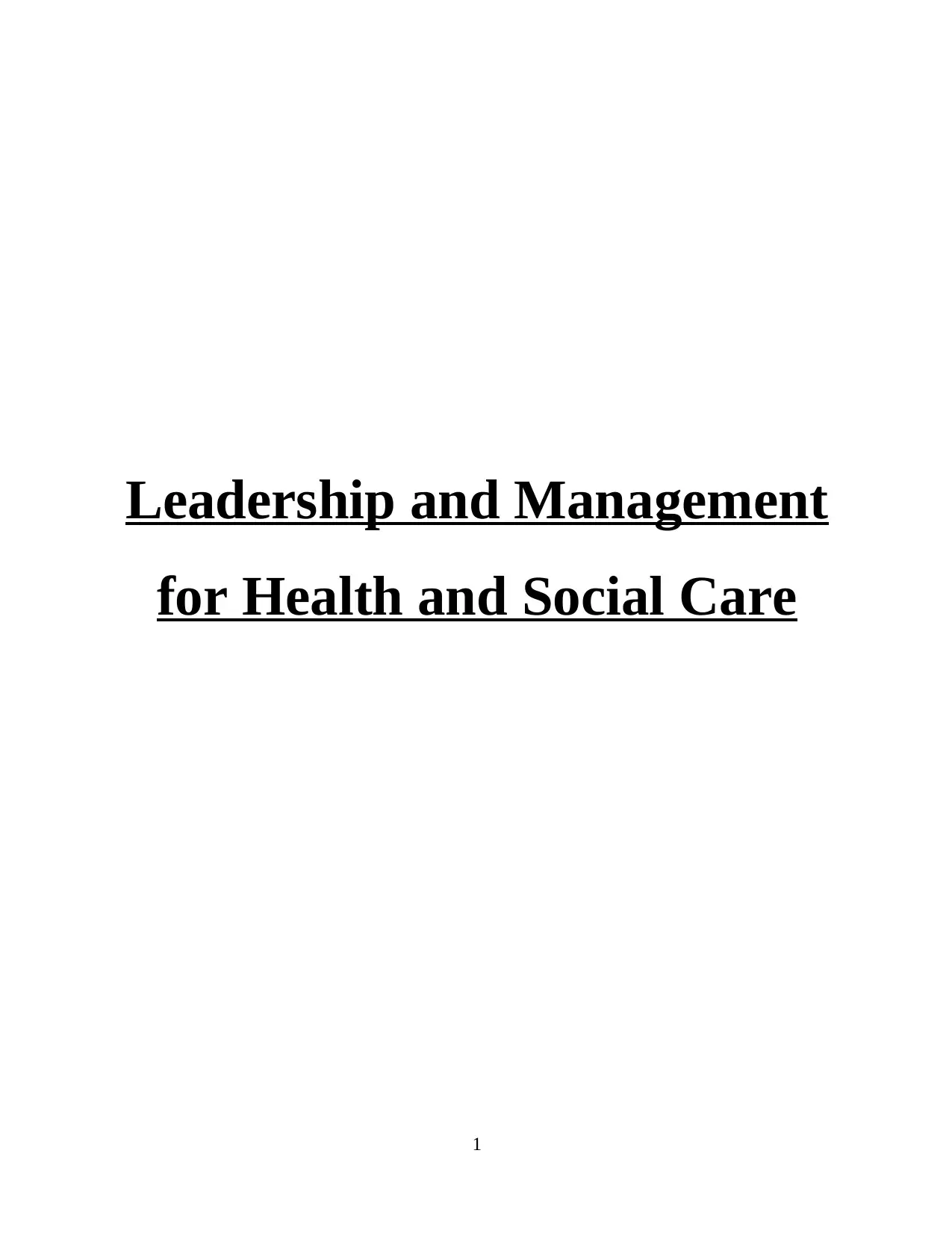
Leadership and Management
for Health and Social Care
1
for Health and Social Care
1
Paraphrase This Document
Need a fresh take? Get an instant paraphrase of this document with our AI Paraphraser
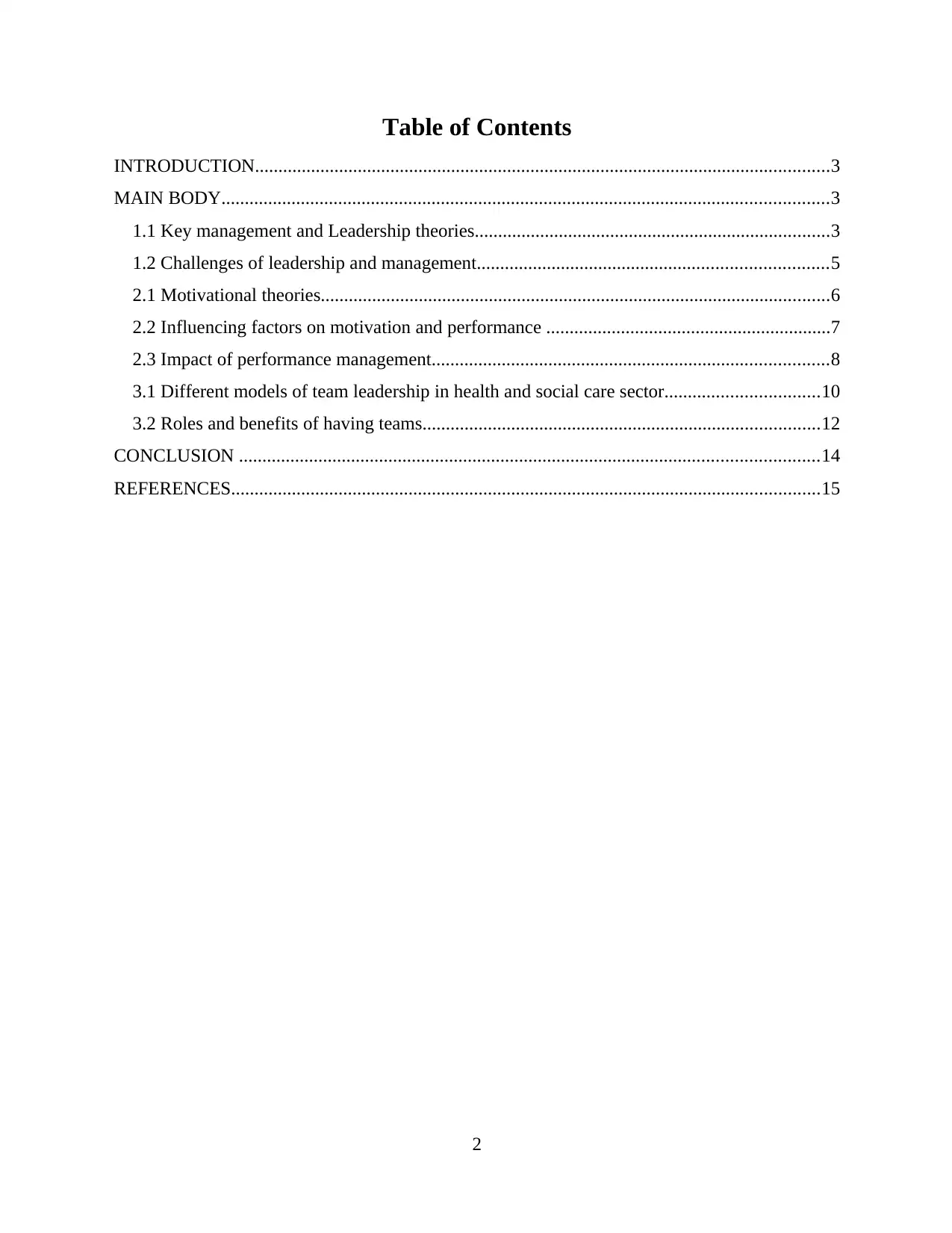
Table of Contents
INTRODUCTION...........................................................................................................................3
MAIN BODY..................................................................................................................................3
1.1 Key management and Leadership theories............................................................................3
1.2 Challenges of leadership and management...........................................................................5
2.1 Motivational theories.............................................................................................................6
2.2 Influencing factors on motivation and performance .............................................................7
2.3 Impact of performance management.....................................................................................8
3.1 Different models of team leadership in health and social care sector.................................10
3.2 Roles and benefits of having teams.....................................................................................12
CONCLUSION ............................................................................................................................14
REFERENCES..............................................................................................................................15
2
INTRODUCTION...........................................................................................................................3
MAIN BODY..................................................................................................................................3
1.1 Key management and Leadership theories............................................................................3
1.2 Challenges of leadership and management...........................................................................5
2.1 Motivational theories.............................................................................................................6
2.2 Influencing factors on motivation and performance .............................................................7
2.3 Impact of performance management.....................................................................................8
3.1 Different models of team leadership in health and social care sector.................................10
3.2 Roles and benefits of having teams.....................................................................................12
CONCLUSION ............................................................................................................................14
REFERENCES..............................................................................................................................15
2
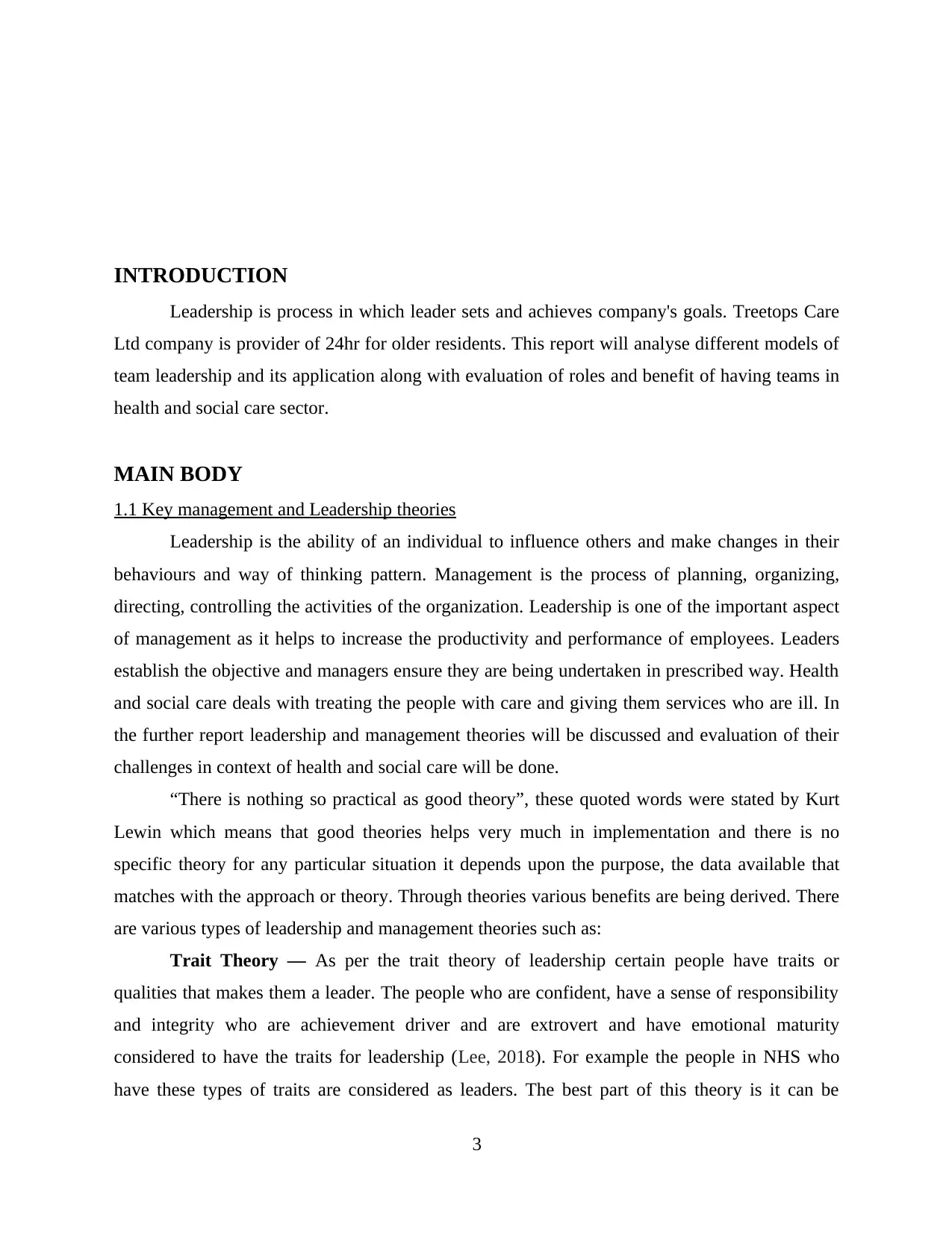
INTRODUCTION
Leadership is process in which leader sets and achieves company's goals. Treetops Care
Ltd company is provider of 24hr for older residents. This report will analyse different models of
team leadership and its application along with evaluation of roles and benefit of having teams in
health and social care sector.
MAIN BODY
1.1 Key management and Leadership theories
Leadership is the ability of an individual to influence others and make changes in their
behaviours and way of thinking pattern. Management is the process of planning, organizing,
directing, controlling the activities of the organization. Leadership is one of the important aspect
of management as it helps to increase the productivity and performance of employees. Leaders
establish the objective and managers ensure they are being undertaken in prescribed way. Health
and social care deals with treating the people with care and giving them services who are ill. In
the further report leadership and management theories will be discussed and evaluation of their
challenges in context of health and social care will be done.
“There is nothing so practical as good theory”, these quoted words were stated by Kurt
Lewin which means that good theories helps very much in implementation and there is no
specific theory for any particular situation it depends upon the purpose, the data available that
matches with the approach or theory. Through theories various benefits are being derived. There
are various types of leadership and management theories such as:
Trait Theory — As per the trait theory of leadership certain people have traits or
qualities that makes them a leader. The people who are confident, have a sense of responsibility
and integrity who are achievement driver and are extrovert and have emotional maturity
considered to have the traits for leadership (Lee, 2018). For example the people in NHS who
have these types of traits are considered as leaders. The best part of this theory is it can be
3
Leadership is process in which leader sets and achieves company's goals. Treetops Care
Ltd company is provider of 24hr for older residents. This report will analyse different models of
team leadership and its application along with evaluation of roles and benefit of having teams in
health and social care sector.
MAIN BODY
1.1 Key management and Leadership theories
Leadership is the ability of an individual to influence others and make changes in their
behaviours and way of thinking pattern. Management is the process of planning, organizing,
directing, controlling the activities of the organization. Leadership is one of the important aspect
of management as it helps to increase the productivity and performance of employees. Leaders
establish the objective and managers ensure they are being undertaken in prescribed way. Health
and social care deals with treating the people with care and giving them services who are ill. In
the further report leadership and management theories will be discussed and evaluation of their
challenges in context of health and social care will be done.
“There is nothing so practical as good theory”, these quoted words were stated by Kurt
Lewin which means that good theories helps very much in implementation and there is no
specific theory for any particular situation it depends upon the purpose, the data available that
matches with the approach or theory. Through theories various benefits are being derived. There
are various types of leadership and management theories such as:
Trait Theory — As per the trait theory of leadership certain people have traits or
qualities that makes them a leader. The people who are confident, have a sense of responsibility
and integrity who are achievement driver and are extrovert and have emotional maturity
considered to have the traits for leadership (Lee, 2018). For example the people in NHS who
have these types of traits are considered as leaders. The best part of this theory is it can be
3
⊘ This is a preview!⊘
Do you want full access?
Subscribe today to unlock all pages.

Trusted by 1+ million students worldwide
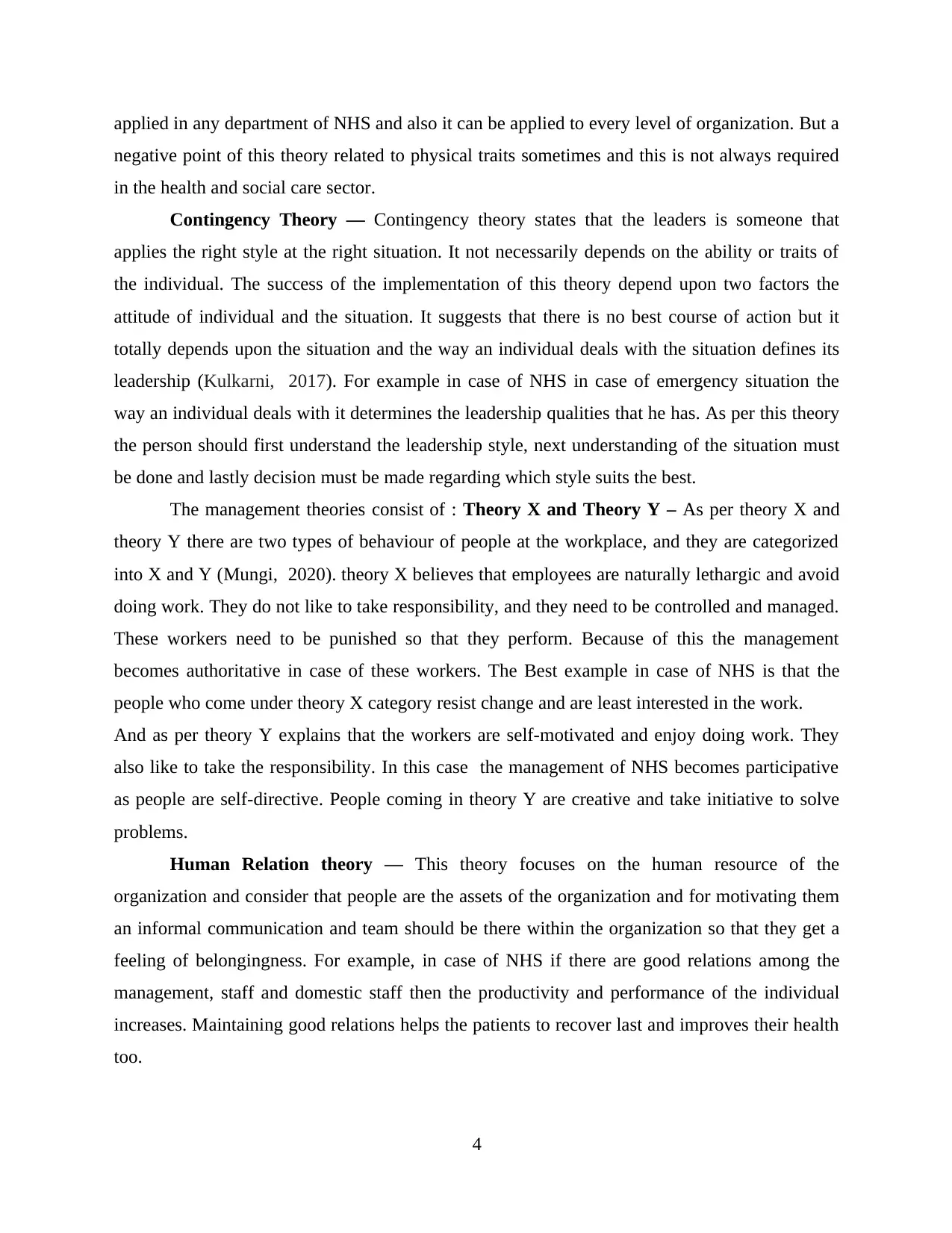
applied in any department of NHS and also it can be applied to every level of organization. But a
negative point of this theory related to physical traits sometimes and this is not always required
in the health and social care sector.
Contingency Theory — Contingency theory states that the leaders is someone that
applies the right style at the right situation. It not necessarily depends on the ability or traits of
the individual. The success of the implementation of this theory depend upon two factors the
attitude of individual and the situation. It suggests that there is no best course of action but it
totally depends upon the situation and the way an individual deals with the situation defines its
leadership (Kulkarni, 2017). For example in case of NHS in case of emergency situation the
way an individual deals with it determines the leadership qualities that he has. As per this theory
the person should first understand the leadership style, next understanding of the situation must
be done and lastly decision must be made regarding which style suits the best.
The management theories consist of : Theory X and Theory Y – As per theory X and
theory Y there are two types of behaviour of people at the workplace, and they are categorized
into X and Y (Mungi, 2020). theory X believes that employees are naturally lethargic and avoid
doing work. They do not like to take responsibility, and they need to be controlled and managed.
These workers need to be punished so that they perform. Because of this the management
becomes authoritative in case of these workers. The Best example in case of NHS is that the
people who come under theory X category resist change and are least interested in the work.
And as per theory Y explains that the workers are self-motivated and enjoy doing work. They
also like to take the responsibility. In this case the management of NHS becomes participative
as people are self-directive. People coming in theory Y are creative and take initiative to solve
problems.
Human Relation theory — This theory focuses on the human resource of the
organization and consider that people are the assets of the organization and for motivating them
an informal communication and team should be there within the organization so that they get a
feeling of belongingness. For example, in case of NHS if there are good relations among the
management, staff and domestic staff then the productivity and performance of the individual
increases. Maintaining good relations helps the patients to recover last and improves their health
too.
4
negative point of this theory related to physical traits sometimes and this is not always required
in the health and social care sector.
Contingency Theory — Contingency theory states that the leaders is someone that
applies the right style at the right situation. It not necessarily depends on the ability or traits of
the individual. The success of the implementation of this theory depend upon two factors the
attitude of individual and the situation. It suggests that there is no best course of action but it
totally depends upon the situation and the way an individual deals with the situation defines its
leadership (Kulkarni, 2017). For example in case of NHS in case of emergency situation the
way an individual deals with it determines the leadership qualities that he has. As per this theory
the person should first understand the leadership style, next understanding of the situation must
be done and lastly decision must be made regarding which style suits the best.
The management theories consist of : Theory X and Theory Y – As per theory X and
theory Y there are two types of behaviour of people at the workplace, and they are categorized
into X and Y (Mungi, 2020). theory X believes that employees are naturally lethargic and avoid
doing work. They do not like to take responsibility, and they need to be controlled and managed.
These workers need to be punished so that they perform. Because of this the management
becomes authoritative in case of these workers. The Best example in case of NHS is that the
people who come under theory X category resist change and are least interested in the work.
And as per theory Y explains that the workers are self-motivated and enjoy doing work. They
also like to take the responsibility. In this case the management of NHS becomes participative
as people are self-directive. People coming in theory Y are creative and take initiative to solve
problems.
Human Relation theory — This theory focuses on the human resource of the
organization and consider that people are the assets of the organization and for motivating them
an informal communication and team should be there within the organization so that they get a
feeling of belongingness. For example, in case of NHS if there are good relations among the
management, staff and domestic staff then the productivity and performance of the individual
increases. Maintaining good relations helps the patients to recover last and improves their health
too.
4
Paraphrase This Document
Need a fresh take? Get an instant paraphrase of this document with our AI Paraphraser
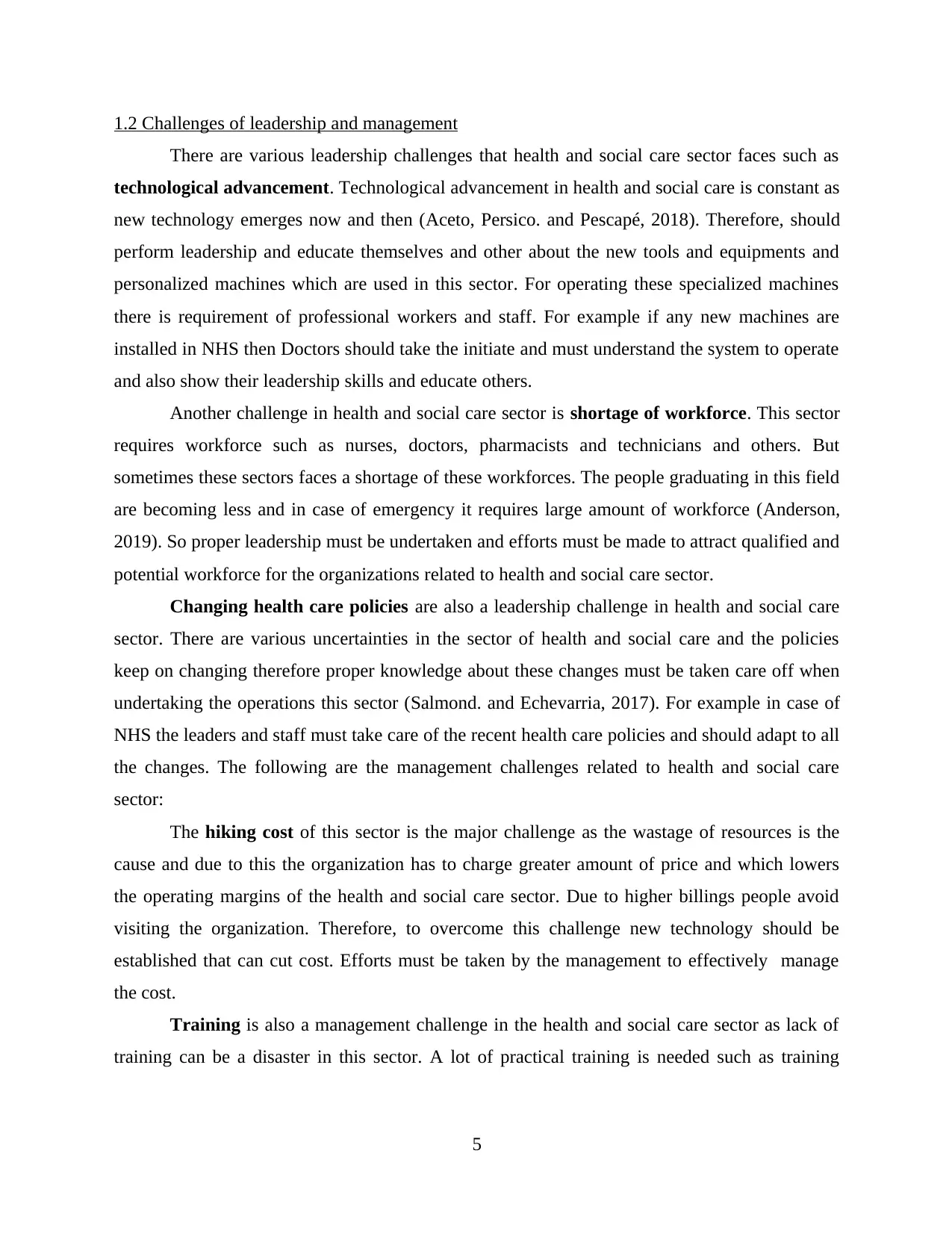
1.2 Challenges of leadership and management
There are various leadership challenges that health and social care sector faces such as
technological advancement. Technological advancement in health and social care is constant as
new technology emerges now and then (Aceto, Persico. and Pescapé, 2018). Therefore, should
perform leadership and educate themselves and other about the new tools and equipments and
personalized machines which are used in this sector. For operating these specialized machines
there is requirement of professional workers and staff. For example if any new machines are
installed in NHS then Doctors should take the initiate and must understand the system to operate
and also show their leadership skills and educate others.
Another challenge in health and social care sector is shortage of workforce. This sector
requires workforce such as nurses, doctors, pharmacists and technicians and others. But
sometimes these sectors faces a shortage of these workforces. The people graduating in this field
are becoming less and in case of emergency it requires large amount of workforce (Anderson,
2019). So proper leadership must be undertaken and efforts must be made to attract qualified and
potential workforce for the organizations related to health and social care sector.
Changing health care policies are also a leadership challenge in health and social care
sector. There are various uncertainties in the sector of health and social care and the policies
keep on changing therefore proper knowledge about these changes must be taken care off when
undertaking the operations this sector (Salmond. and Echevarria, 2017). For example in case of
NHS the leaders and staff must take care of the recent health care policies and should adapt to all
the changes. The following are the management challenges related to health and social care
sector:
The hiking cost of this sector is the major challenge as the wastage of resources is the
cause and due to this the organization has to charge greater amount of price and which lowers
the operating margins of the health and social care sector. Due to higher billings people avoid
visiting the organization. Therefore, to overcome this challenge new technology should be
established that can cut cost. Efforts must be taken by the management to effectively manage
the cost.
Training is also a management challenge in the health and social care sector as lack of
training can be a disaster in this sector. A lot of practical training is needed such as training
5
There are various leadership challenges that health and social care sector faces such as
technological advancement. Technological advancement in health and social care is constant as
new technology emerges now and then (Aceto, Persico. and Pescapé, 2018). Therefore, should
perform leadership and educate themselves and other about the new tools and equipments and
personalized machines which are used in this sector. For operating these specialized machines
there is requirement of professional workers and staff. For example if any new machines are
installed in NHS then Doctors should take the initiate and must understand the system to operate
and also show their leadership skills and educate others.
Another challenge in health and social care sector is shortage of workforce. This sector
requires workforce such as nurses, doctors, pharmacists and technicians and others. But
sometimes these sectors faces a shortage of these workforces. The people graduating in this field
are becoming less and in case of emergency it requires large amount of workforce (Anderson,
2019). So proper leadership must be undertaken and efforts must be made to attract qualified and
potential workforce for the organizations related to health and social care sector.
Changing health care policies are also a leadership challenge in health and social care
sector. There are various uncertainties in the sector of health and social care and the policies
keep on changing therefore proper knowledge about these changes must be taken care off when
undertaking the operations this sector (Salmond. and Echevarria, 2017). For example in case of
NHS the leaders and staff must take care of the recent health care policies and should adapt to all
the changes. The following are the management challenges related to health and social care
sector:
The hiking cost of this sector is the major challenge as the wastage of resources is the
cause and due to this the organization has to charge greater amount of price and which lowers
the operating margins of the health and social care sector. Due to higher billings people avoid
visiting the organization. Therefore, to overcome this challenge new technology should be
established that can cut cost. Efforts must be taken by the management to effectively manage
the cost.
Training is also a management challenge in the health and social care sector as lack of
training can be a disaster in this sector. A lot of practical training is needed such as training
5
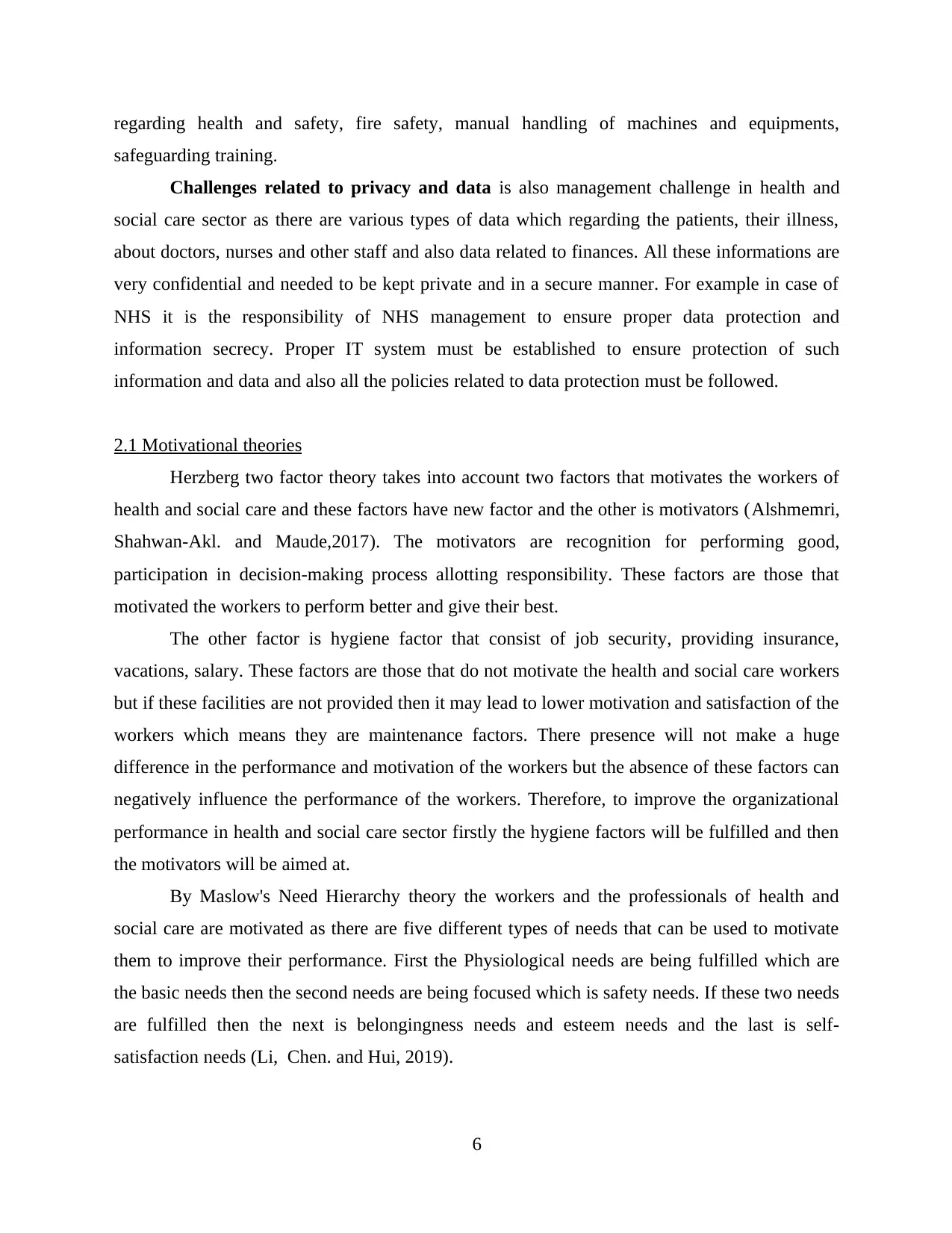
regarding health and safety, fire safety, manual handling of machines and equipments,
safeguarding training.
Challenges related to privacy and data is also management challenge in health and
social care sector as there are various types of data which regarding the patients, their illness,
about doctors, nurses and other staff and also data related to finances. All these informations are
very confidential and needed to be kept private and in a secure manner. For example in case of
NHS it is the responsibility of NHS management to ensure proper data protection and
information secrecy. Proper IT system must be established to ensure protection of such
information and data and also all the policies related to data protection must be followed.
2.1 Motivational theories
Herzberg two factor theory takes into account two factors that motivates the workers of
health and social care and these factors have new factor and the other is motivators (Alshmemri,
Shahwan-Akl. and Maude,2017). The motivators are recognition for performing good,
participation in decision-making process allotting responsibility. These factors are those that
motivated the workers to perform better and give their best.
The other factor is hygiene factor that consist of job security, providing insurance,
vacations, salary. These factors are those that do not motivate the health and social care workers
but if these facilities are not provided then it may lead to lower motivation and satisfaction of the
workers which means they are maintenance factors. There presence will not make a huge
difference in the performance and motivation of the workers but the absence of these factors can
negatively influence the performance of the workers. Therefore, to improve the organizational
performance in health and social care sector firstly the hygiene factors will be fulfilled and then
the motivators will be aimed at.
By Maslow's Need Hierarchy theory the workers and the professionals of health and
social care are motivated as there are five different types of needs that can be used to motivate
them to improve their performance. First the Physiological needs are being fulfilled which are
the basic needs then the second needs are being focused which is safety needs. If these two needs
are fulfilled then the next is belongingness needs and esteem needs and the last is self-
satisfaction needs (Li, Chen. and Hui, 2019).
6
safeguarding training.
Challenges related to privacy and data is also management challenge in health and
social care sector as there are various types of data which regarding the patients, their illness,
about doctors, nurses and other staff and also data related to finances. All these informations are
very confidential and needed to be kept private and in a secure manner. For example in case of
NHS it is the responsibility of NHS management to ensure proper data protection and
information secrecy. Proper IT system must be established to ensure protection of such
information and data and also all the policies related to data protection must be followed.
2.1 Motivational theories
Herzberg two factor theory takes into account two factors that motivates the workers of
health and social care and these factors have new factor and the other is motivators (Alshmemri,
Shahwan-Akl. and Maude,2017). The motivators are recognition for performing good,
participation in decision-making process allotting responsibility. These factors are those that
motivated the workers to perform better and give their best.
The other factor is hygiene factor that consist of job security, providing insurance,
vacations, salary. These factors are those that do not motivate the health and social care workers
but if these facilities are not provided then it may lead to lower motivation and satisfaction of the
workers which means they are maintenance factors. There presence will not make a huge
difference in the performance and motivation of the workers but the absence of these factors can
negatively influence the performance of the workers. Therefore, to improve the organizational
performance in health and social care sector firstly the hygiene factors will be fulfilled and then
the motivators will be aimed at.
By Maslow's Need Hierarchy theory the workers and the professionals of health and
social care are motivated as there are five different types of needs that can be used to motivate
them to improve their performance. First the Physiological needs are being fulfilled which are
the basic needs then the second needs are being focused which is safety needs. If these two needs
are fulfilled then the next is belongingness needs and esteem needs and the last is self-
satisfaction needs (Li, Chen. and Hui, 2019).
6
⊘ This is a preview!⊘
Do you want full access?
Subscribe today to unlock all pages.

Trusted by 1+ million students worldwide
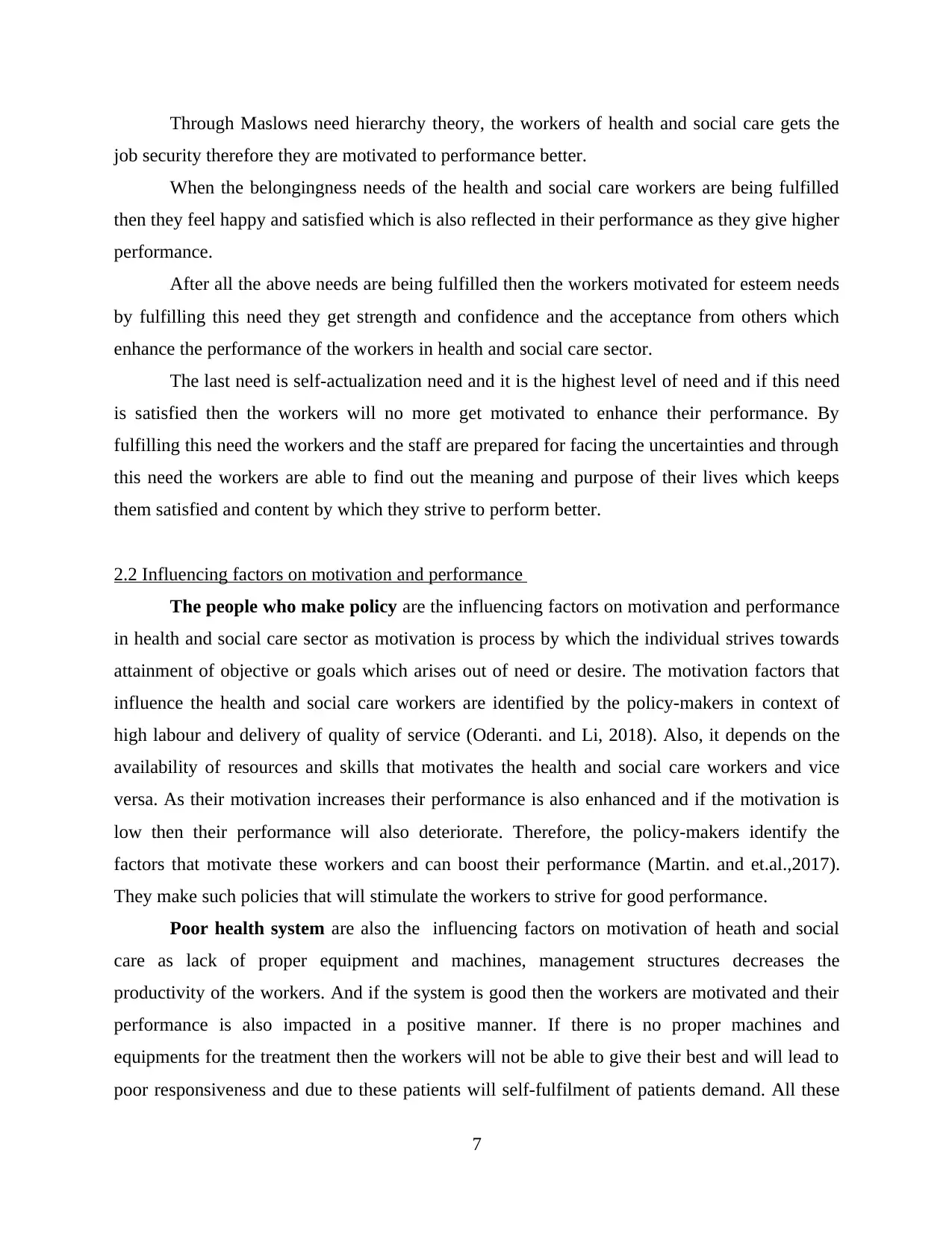
Through Maslows need hierarchy theory, the workers of health and social care gets the
job security therefore they are motivated to performance better.
When the belongingness needs of the health and social care workers are being fulfilled
then they feel happy and satisfied which is also reflected in their performance as they give higher
performance.
After all the above needs are being fulfilled then the workers motivated for esteem needs
by fulfilling this need they get strength and confidence and the acceptance from others which
enhance the performance of the workers in health and social care sector.
The last need is self-actualization need and it is the highest level of need and if this need
is satisfied then the workers will no more get motivated to enhance their performance. By
fulfilling this need the workers and the staff are prepared for facing the uncertainties and through
this need the workers are able to find out the meaning and purpose of their lives which keeps
them satisfied and content by which they strive to perform better.
2.2 Influencing factors on motivation and performance
The people who make policy are the influencing factors on motivation and performance
in health and social care sector as motivation is process by which the individual strives towards
attainment of objective or goals which arises out of need or desire. The motivation factors that
influence the health and social care workers are identified by the policy-makers in context of
high labour and delivery of quality of service (Oderanti. and Li, 2018). Also, it depends on the
availability of resources and skills that motivates the health and social care workers and vice
versa. As their motivation increases their performance is also enhanced and if the motivation is
low then their performance will also deteriorate. Therefore, the policy-makers identify the
factors that motivate these workers and can boost their performance (Martin. and et.al.,2017).
They make such policies that will stimulate the workers to strive for good performance.
Poor health system are also the influencing factors on motivation of heath and social
care as lack of proper equipment and machines, management structures decreases the
productivity of the workers. And if the system is good then the workers are motivated and their
performance is also impacted in a positive manner. If there is no proper machines and
equipments for the treatment then the workers will not be able to give their best and will lead to
poor responsiveness and due to these patients will self-fulfilment of patients demand. All these
7
job security therefore they are motivated to performance better.
When the belongingness needs of the health and social care workers are being fulfilled
then they feel happy and satisfied which is also reflected in their performance as they give higher
performance.
After all the above needs are being fulfilled then the workers motivated for esteem needs
by fulfilling this need they get strength and confidence and the acceptance from others which
enhance the performance of the workers in health and social care sector.
The last need is self-actualization need and it is the highest level of need and if this need
is satisfied then the workers will no more get motivated to enhance their performance. By
fulfilling this need the workers and the staff are prepared for facing the uncertainties and through
this need the workers are able to find out the meaning and purpose of their lives which keeps
them satisfied and content by which they strive to perform better.
2.2 Influencing factors on motivation and performance
The people who make policy are the influencing factors on motivation and performance
in health and social care sector as motivation is process by which the individual strives towards
attainment of objective or goals which arises out of need or desire. The motivation factors that
influence the health and social care workers are identified by the policy-makers in context of
high labour and delivery of quality of service (Oderanti. and Li, 2018). Also, it depends on the
availability of resources and skills that motivates the health and social care workers and vice
versa. As their motivation increases their performance is also enhanced and if the motivation is
low then their performance will also deteriorate. Therefore, the policy-makers identify the
factors that motivate these workers and can boost their performance (Martin. and et.al.,2017).
They make such policies that will stimulate the workers to strive for good performance.
Poor health system are also the influencing factors on motivation of heath and social
care as lack of proper equipment and machines, management structures decreases the
productivity of the workers. And if the system is good then the workers are motivated and their
performance is also impacted in a positive manner. If there is no proper machines and
equipments for the treatment then the workers will not be able to give their best and will lead to
poor responsiveness and due to these patients will self-fulfilment of patients demand. All these
7
Paraphrase This Document
Need a fresh take? Get an instant paraphrase of this document with our AI Paraphraser
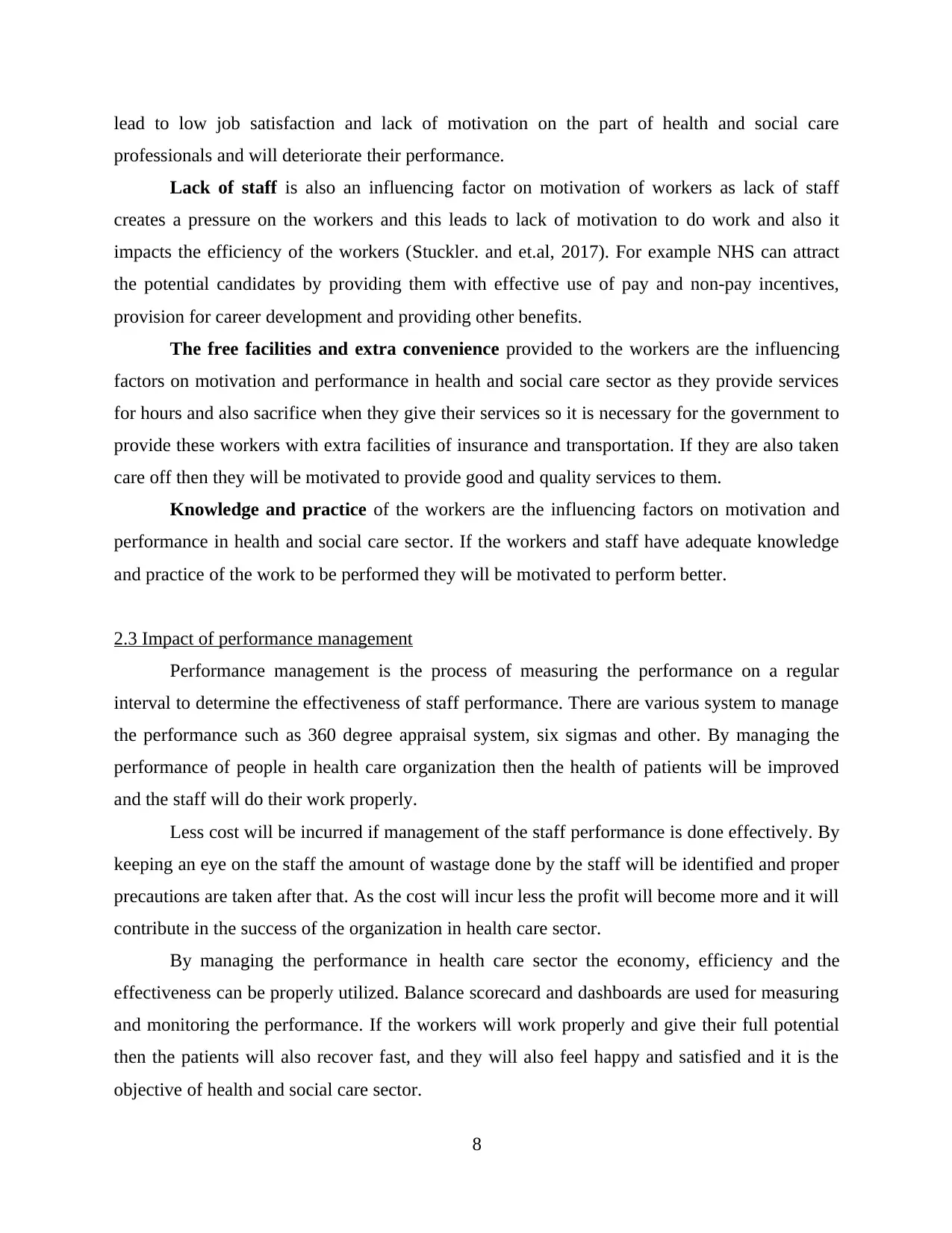
lead to low job satisfaction and lack of motivation on the part of health and social care
professionals and will deteriorate their performance.
Lack of staff is also an influencing factor on motivation of workers as lack of staff
creates a pressure on the workers and this leads to lack of motivation to do work and also it
impacts the efficiency of the workers (Stuckler. and et.al, 2017). For example NHS can attract
the potential candidates by providing them with effective use of pay and non-pay incentives,
provision for career development and providing other benefits.
The free facilities and extra convenience provided to the workers are the influencing
factors on motivation and performance in health and social care sector as they provide services
for hours and also sacrifice when they give their services so it is necessary for the government to
provide these workers with extra facilities of insurance and transportation. If they are also taken
care off then they will be motivated to provide good and quality services to them.
Knowledge and practice of the workers are the influencing factors on motivation and
performance in health and social care sector. If the workers and staff have adequate knowledge
and practice of the work to be performed they will be motivated to perform better.
2.3 Impact of performance management
Performance management is the process of measuring the performance on a regular
interval to determine the effectiveness of staff performance. There are various system to manage
the performance such as 360 degree appraisal system, six sigmas and other. By managing the
performance of people in health care organization then the health of patients will be improved
and the staff will do their work properly.
Less cost will be incurred if management of the staff performance is done effectively. By
keeping an eye on the staff the amount of wastage done by the staff will be identified and proper
precautions are taken after that. As the cost will incur less the profit will become more and it will
contribute in the success of the organization in health care sector.
By managing the performance in health care sector the economy, efficiency and the
effectiveness can be properly utilized. Balance scorecard and dashboards are used for measuring
and monitoring the performance. If the workers will work properly and give their full potential
then the patients will also recover fast, and they will also feel happy and satisfied and it is the
objective of health and social care sector.
8
professionals and will deteriorate their performance.
Lack of staff is also an influencing factor on motivation of workers as lack of staff
creates a pressure on the workers and this leads to lack of motivation to do work and also it
impacts the efficiency of the workers (Stuckler. and et.al, 2017). For example NHS can attract
the potential candidates by providing them with effective use of pay and non-pay incentives,
provision for career development and providing other benefits.
The free facilities and extra convenience provided to the workers are the influencing
factors on motivation and performance in health and social care sector as they provide services
for hours and also sacrifice when they give their services so it is necessary for the government to
provide these workers with extra facilities of insurance and transportation. If they are also taken
care off then they will be motivated to provide good and quality services to them.
Knowledge and practice of the workers are the influencing factors on motivation and
performance in health and social care sector. If the workers and staff have adequate knowledge
and practice of the work to be performed they will be motivated to perform better.
2.3 Impact of performance management
Performance management is the process of measuring the performance on a regular
interval to determine the effectiveness of staff performance. There are various system to manage
the performance such as 360 degree appraisal system, six sigmas and other. By managing the
performance of people in health care organization then the health of patients will be improved
and the staff will do their work properly.
Less cost will be incurred if management of the staff performance is done effectively. By
keeping an eye on the staff the amount of wastage done by the staff will be identified and proper
precautions are taken after that. As the cost will incur less the profit will become more and it will
contribute in the success of the organization in health care sector.
By managing the performance in health care sector the economy, efficiency and the
effectiveness can be properly utilized. Balance scorecard and dashboards are used for measuring
and monitoring the performance. If the workers will work properly and give their full potential
then the patients will also recover fast, and they will also feel happy and satisfied and it is the
objective of health and social care sector.
8
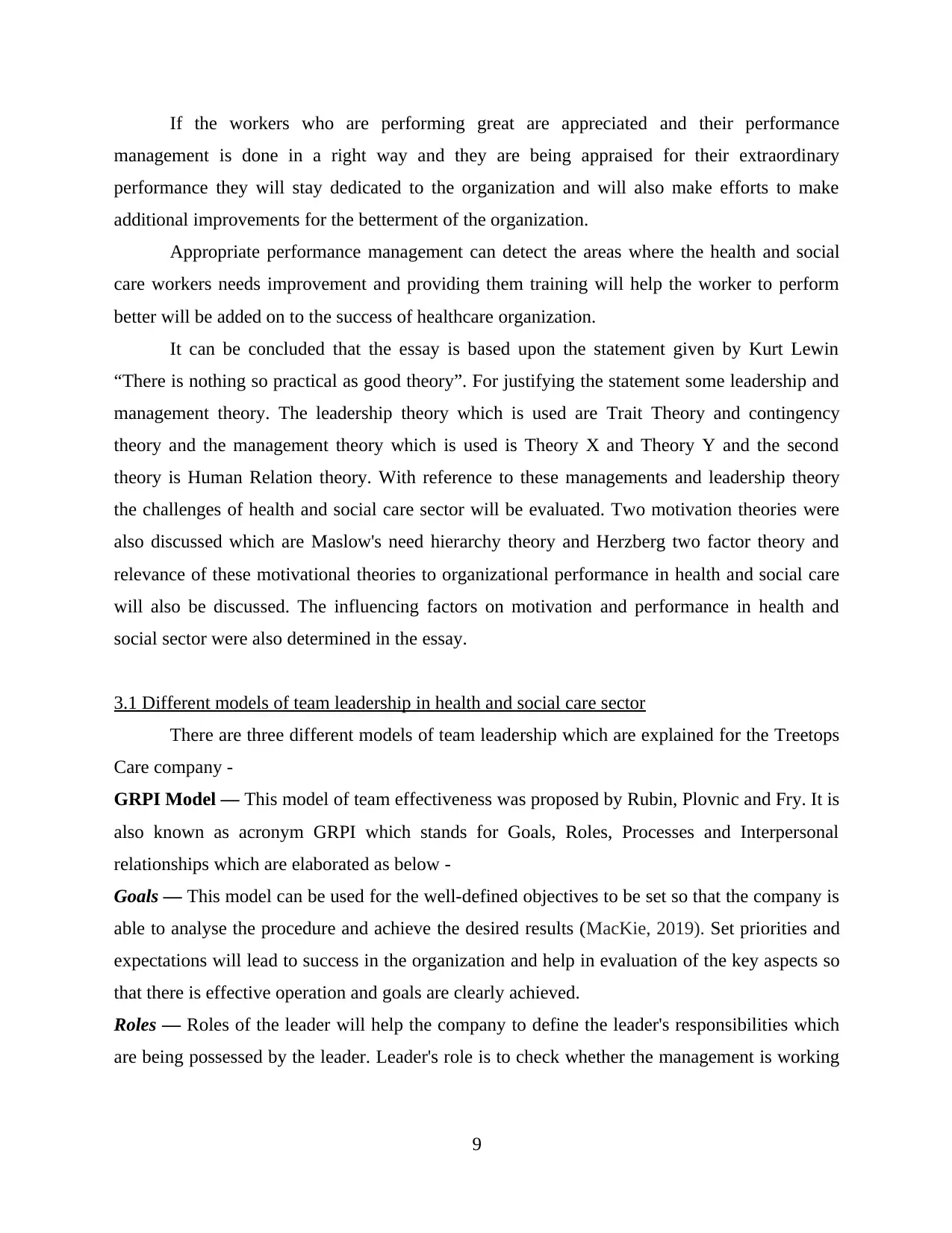
If the workers who are performing great are appreciated and their performance
management is done in a right way and they are being appraised for their extraordinary
performance they will stay dedicated to the organization and will also make efforts to make
additional improvements for the betterment of the organization.
Appropriate performance management can detect the areas where the health and social
care workers needs improvement and providing them training will help the worker to perform
better will be added on to the success of healthcare organization.
It can be concluded that the essay is based upon the statement given by Kurt Lewin
“There is nothing so practical as good theory”. For justifying the statement some leadership and
management theory. The leadership theory which is used are Trait Theory and contingency
theory and the management theory which is used is Theory X and Theory Y and the second
theory is Human Relation theory. With reference to these managements and leadership theory
the challenges of health and social care sector will be evaluated. Two motivation theories were
also discussed which are Maslow's need hierarchy theory and Herzberg two factor theory and
relevance of these motivational theories to organizational performance in health and social care
will also be discussed. The influencing factors on motivation and performance in health and
social sector were also determined in the essay.
3.1 Different models of team leadership in health and social care sector
There are three different models of team leadership which are explained for the Treetops
Care company -
GRPI Model — This model of team effectiveness was proposed by Rubin, Plovnic and Fry. It is
also known as acronym GRPI which stands for Goals, Roles, Processes and Interpersonal
relationships which are elaborated as below -
Goals — This model can be used for the well-defined objectives to be set so that the company is
able to analyse the procedure and achieve the desired results (MacKie, 2019). Set priorities and
expectations will lead to success in the organization and help in evaluation of the key aspects so
that there is effective operation and goals are clearly achieved.
Roles — Roles of the leader will help the company to define the leader's responsibilities which
are being possessed by the leader. Leader's role is to check whether the management is working
9
management is done in a right way and they are being appraised for their extraordinary
performance they will stay dedicated to the organization and will also make efforts to make
additional improvements for the betterment of the organization.
Appropriate performance management can detect the areas where the health and social
care workers needs improvement and providing them training will help the worker to perform
better will be added on to the success of healthcare organization.
It can be concluded that the essay is based upon the statement given by Kurt Lewin
“There is nothing so practical as good theory”. For justifying the statement some leadership and
management theory. The leadership theory which is used are Trait Theory and contingency
theory and the management theory which is used is Theory X and Theory Y and the second
theory is Human Relation theory. With reference to these managements and leadership theory
the challenges of health and social care sector will be evaluated. Two motivation theories were
also discussed which are Maslow's need hierarchy theory and Herzberg two factor theory and
relevance of these motivational theories to organizational performance in health and social care
will also be discussed. The influencing factors on motivation and performance in health and
social sector were also determined in the essay.
3.1 Different models of team leadership in health and social care sector
There are three different models of team leadership which are explained for the Treetops
Care company -
GRPI Model — This model of team effectiveness was proposed by Rubin, Plovnic and Fry. It is
also known as acronym GRPI which stands for Goals, Roles, Processes and Interpersonal
relationships which are elaborated as below -
Goals — This model can be used for the well-defined objectives to be set so that the company is
able to analyse the procedure and achieve the desired results (MacKie, 2019). Set priorities and
expectations will lead to success in the organization and help in evaluation of the key aspects so
that there is effective operation and goals are clearly achieved.
Roles — Roles of the leader will help the company to define the leader's responsibilities which
are being possessed by the leader. Leader's role is to check whether the management is working
9
⊘ This is a preview!⊘
Do you want full access?
Subscribe today to unlock all pages.

Trusted by 1+ million students worldwide
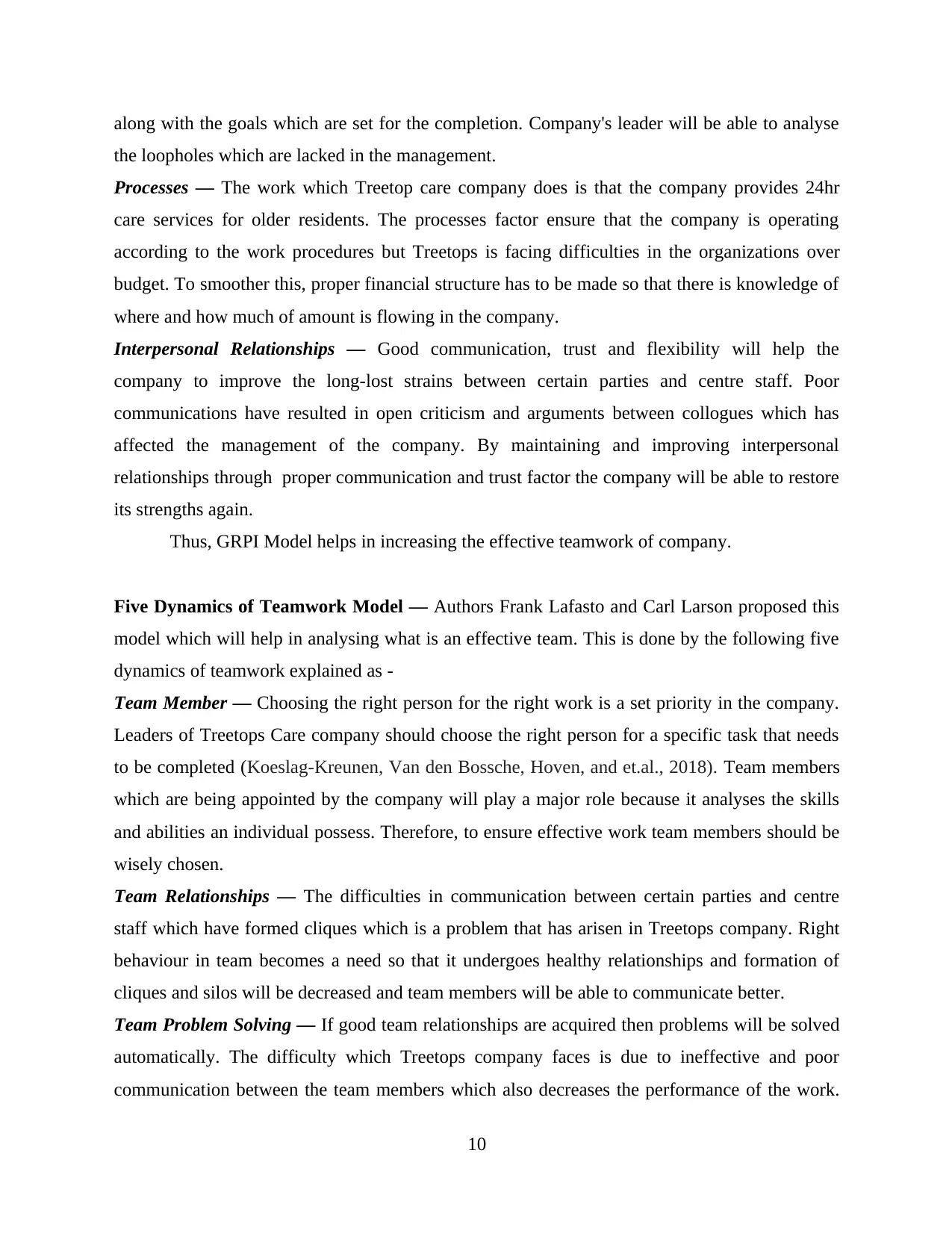
along with the goals which are set for the completion. Company's leader will be able to analyse
the loopholes which are lacked in the management.
Processes — The work which Treetop care company does is that the company provides 24hr
care services for older residents. The processes factor ensure that the company is operating
according to the work procedures but Treetops is facing difficulties in the organizations over
budget. To smoother this, proper financial structure has to be made so that there is knowledge of
where and how much of amount is flowing in the company.
Interpersonal Relationships — Good communication, trust and flexibility will help the
company to improve the long-lost strains between certain parties and centre staff. Poor
communications have resulted in open criticism and arguments between collogues which has
affected the management of the company. By maintaining and improving interpersonal
relationships through proper communication and trust factor the company will be able to restore
its strengths again.
Thus, GRPI Model helps in increasing the effective teamwork of company.
Five Dynamics of Teamwork Model — Authors Frank Lafasto and Carl Larson proposed this
model which will help in analysing what is an effective team. This is done by the following five
dynamics of teamwork explained as -
Team Member — Choosing the right person for the right work is a set priority in the company.
Leaders of Treetops Care company should choose the right person for a specific task that needs
to be completed (Koeslag-Kreunen, Van den Bossche, Hoven, and et.al., 2018). Team members
which are being appointed by the company will play a major role because it analyses the skills
and abilities an individual possess. Therefore, to ensure effective work team members should be
wisely chosen.
Team Relationships — The difficulties in communication between certain parties and centre
staff which have formed cliques which is a problem that has arisen in Treetops company. Right
behaviour in team becomes a need so that it undergoes healthy relationships and formation of
cliques and silos will be decreased and team members will be able to communicate better.
Team Problem Solving — If good team relationships are acquired then problems will be solved
automatically. The difficulty which Treetops company faces is due to ineffective and poor
communication between the team members which also decreases the performance of the work.
10
the loopholes which are lacked in the management.
Processes — The work which Treetop care company does is that the company provides 24hr
care services for older residents. The processes factor ensure that the company is operating
according to the work procedures but Treetops is facing difficulties in the organizations over
budget. To smoother this, proper financial structure has to be made so that there is knowledge of
where and how much of amount is flowing in the company.
Interpersonal Relationships — Good communication, trust and flexibility will help the
company to improve the long-lost strains between certain parties and centre staff. Poor
communications have resulted in open criticism and arguments between collogues which has
affected the management of the company. By maintaining and improving interpersonal
relationships through proper communication and trust factor the company will be able to restore
its strengths again.
Thus, GRPI Model helps in increasing the effective teamwork of company.
Five Dynamics of Teamwork Model — Authors Frank Lafasto and Carl Larson proposed this
model which will help in analysing what is an effective team. This is done by the following five
dynamics of teamwork explained as -
Team Member — Choosing the right person for the right work is a set priority in the company.
Leaders of Treetops Care company should choose the right person for a specific task that needs
to be completed (Koeslag-Kreunen, Van den Bossche, Hoven, and et.al., 2018). Team members
which are being appointed by the company will play a major role because it analyses the skills
and abilities an individual possess. Therefore, to ensure effective work team members should be
wisely chosen.
Team Relationships — The difficulties in communication between certain parties and centre
staff which have formed cliques which is a problem that has arisen in Treetops company. Right
behaviour in team becomes a need so that it undergoes healthy relationships and formation of
cliques and silos will be decreased and team members will be able to communicate better.
Team Problem Solving — If good team relationships are acquired then problems will be solved
automatically. The difficulty which Treetops company faces is due to ineffective and poor
communication between the team members which also decreases the performance of the work.
10
Paraphrase This Document
Need a fresh take? Get an instant paraphrase of this document with our AI Paraphraser
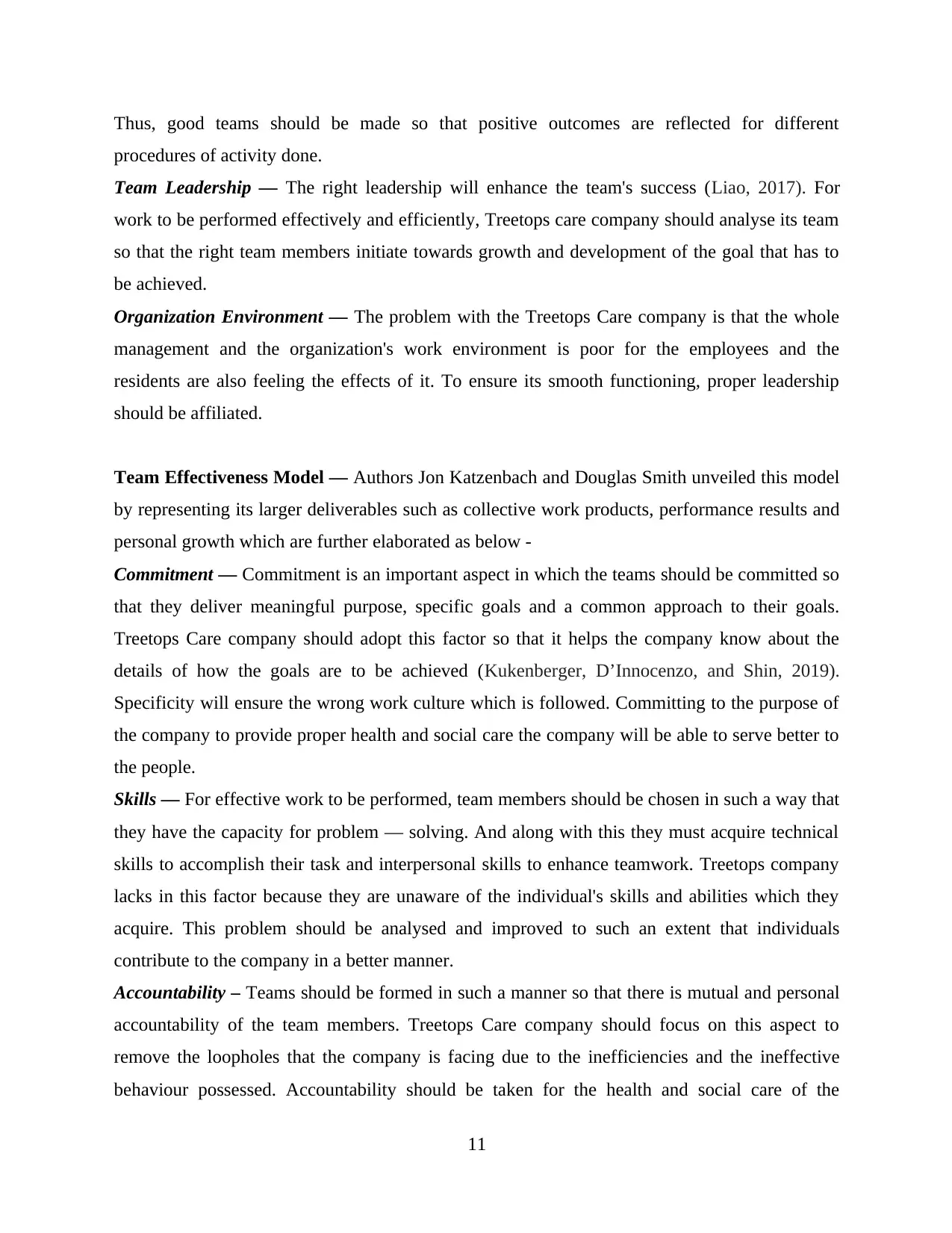
Thus, good teams should be made so that positive outcomes are reflected for different
procedures of activity done.
Team Leadership — The right leadership will enhance the team's success (Liao, 2017). For
work to be performed effectively and efficiently, Treetops care company should analyse its team
so that the right team members initiate towards growth and development of the goal that has to
be achieved.
Organization Environment — The problem with the Treetops Care company is that the whole
management and the organization's work environment is poor for the employees and the
residents are also feeling the effects of it. To ensure its smooth functioning, proper leadership
should be affiliated.
Team Effectiveness Model — Authors Jon Katzenbach and Douglas Smith unveiled this model
by representing its larger deliverables such as collective work products, performance results and
personal growth which are further elaborated as below -
Commitment — Commitment is an important aspect in which the teams should be committed so
that they deliver meaningful purpose, specific goals and a common approach to their goals.
Treetops Care company should adopt this factor so that it helps the company know about the
details of how the goals are to be achieved (Kukenberger, D’Innocenzo, and Shin, 2019).
Specificity will ensure the wrong work culture which is followed. Committing to the purpose of
the company to provide proper health and social care the company will be able to serve better to
the people.
Skills — For effective work to be performed, team members should be chosen in such a way that
they have the capacity for problem — solving. And along with this they must acquire technical
skills to accomplish their task and interpersonal skills to enhance teamwork. Treetops company
lacks in this factor because they are unaware of the individual's skills and abilities which they
acquire. This problem should be analysed and improved to such an extent that individuals
contribute to the company in a better manner.
Accountability – Teams should be formed in such a manner so that there is mutual and personal
accountability of the team members. Treetops Care company should focus on this aspect to
remove the loopholes that the company is facing due to the inefficiencies and the ineffective
behaviour possessed. Accountability should be taken for the health and social care of the
11
procedures of activity done.
Team Leadership — The right leadership will enhance the team's success (Liao, 2017). For
work to be performed effectively and efficiently, Treetops care company should analyse its team
so that the right team members initiate towards growth and development of the goal that has to
be achieved.
Organization Environment — The problem with the Treetops Care company is that the whole
management and the organization's work environment is poor for the employees and the
residents are also feeling the effects of it. To ensure its smooth functioning, proper leadership
should be affiliated.
Team Effectiveness Model — Authors Jon Katzenbach and Douglas Smith unveiled this model
by representing its larger deliverables such as collective work products, performance results and
personal growth which are further elaborated as below -
Commitment — Commitment is an important aspect in which the teams should be committed so
that they deliver meaningful purpose, specific goals and a common approach to their goals.
Treetops Care company should adopt this factor so that it helps the company know about the
details of how the goals are to be achieved (Kukenberger, D’Innocenzo, and Shin, 2019).
Specificity will ensure the wrong work culture which is followed. Committing to the purpose of
the company to provide proper health and social care the company will be able to serve better to
the people.
Skills — For effective work to be performed, team members should be chosen in such a way that
they have the capacity for problem — solving. And along with this they must acquire technical
skills to accomplish their task and interpersonal skills to enhance teamwork. Treetops company
lacks in this factor because they are unaware of the individual's skills and abilities which they
acquire. This problem should be analysed and improved to such an extent that individuals
contribute to the company in a better manner.
Accountability – Teams should be formed in such a manner so that there is mutual and personal
accountability of the team members. Treetops Care company should focus on this aspect to
remove the loopholes that the company is facing due to the inefficiencies and the ineffective
behaviour possessed. Accountability should be taken for the health and social care of the
11
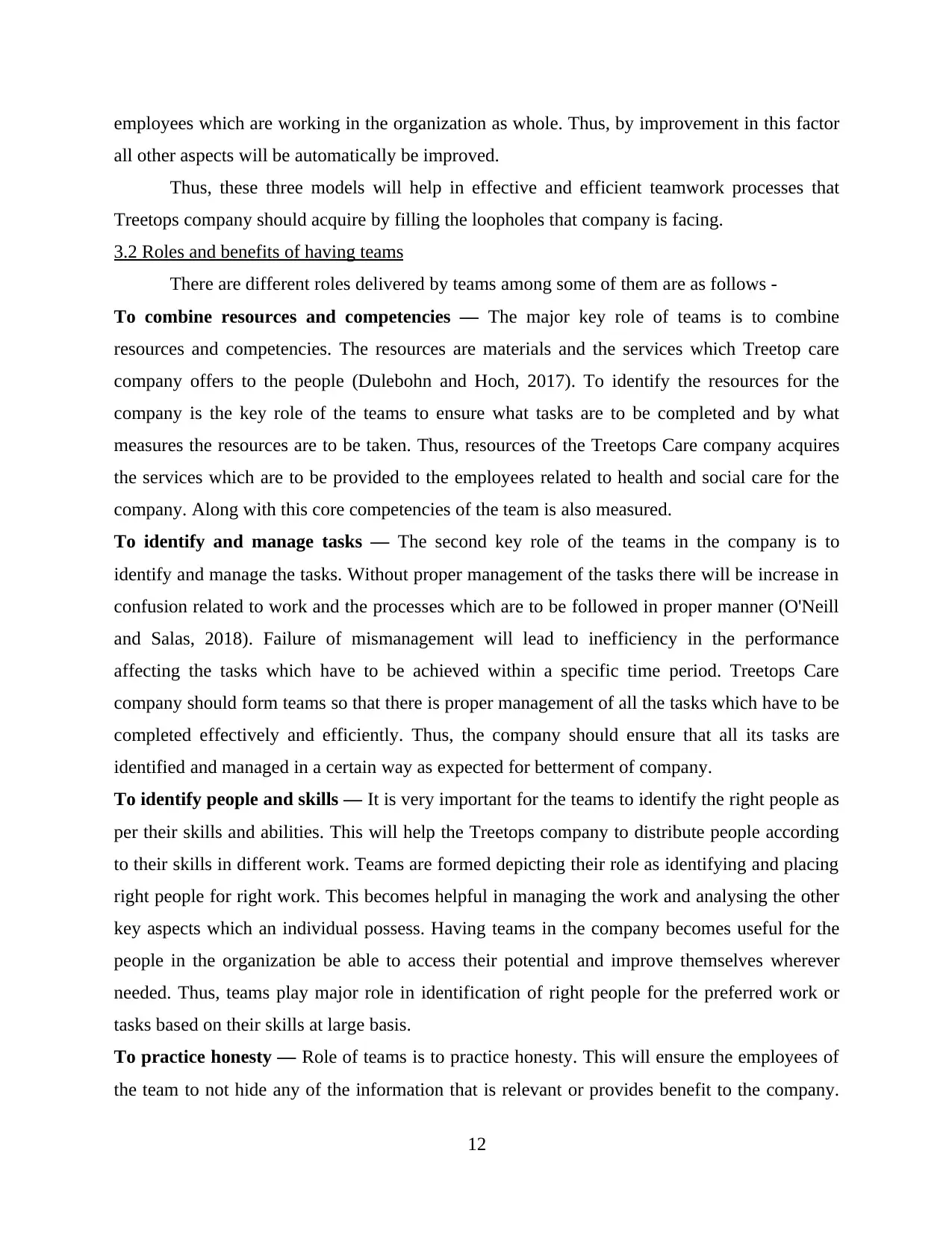
employees which are working in the organization as whole. Thus, by improvement in this factor
all other aspects will be automatically be improved.
Thus, these three models will help in effective and efficient teamwork processes that
Treetops company should acquire by filling the loopholes that company is facing.
3.2 Roles and benefits of having teams
There are different roles delivered by teams among some of them are as follows -
To combine resources and competencies — The major key role of teams is to combine
resources and competencies. The resources are materials and the services which Treetop care
company offers to the people (Dulebohn and Hoch, 2017). To identify the resources for the
company is the key role of the teams to ensure what tasks are to be completed and by what
measures the resources are to be taken. Thus, resources of the Treetops Care company acquires
the services which are to be provided to the employees related to health and social care for the
company. Along with this core competencies of the team is also measured.
To identify and manage tasks — The second key role of the teams in the company is to
identify and manage the tasks. Without proper management of the tasks there will be increase in
confusion related to work and the processes which are to be followed in proper manner (O'Neill
and Salas, 2018). Failure of mismanagement will lead to inefficiency in the performance
affecting the tasks which have to be achieved within a specific time period. Treetops Care
company should form teams so that there is proper management of all the tasks which have to be
completed effectively and efficiently. Thus, the company should ensure that all its tasks are
identified and managed in a certain way as expected for betterment of company.
To identify people and skills — It is very important for the teams to identify the right people as
per their skills and abilities. This will help the Treetops company to distribute people according
to their skills in different work. Teams are formed depicting their role as identifying and placing
right people for right work. This becomes helpful in managing the work and analysing the other
key aspects which an individual possess. Having teams in the company becomes useful for the
people in the organization be able to access their potential and improve themselves wherever
needed. Thus, teams play major role in identification of right people for the preferred work or
tasks based on their skills at large basis.
To practice honesty — Role of teams is to practice honesty. This will ensure the employees of
the team to not hide any of the information that is relevant or provides benefit to the company.
12
all other aspects will be automatically be improved.
Thus, these three models will help in effective and efficient teamwork processes that
Treetops company should acquire by filling the loopholes that company is facing.
3.2 Roles and benefits of having teams
There are different roles delivered by teams among some of them are as follows -
To combine resources and competencies — The major key role of teams is to combine
resources and competencies. The resources are materials and the services which Treetop care
company offers to the people (Dulebohn and Hoch, 2017). To identify the resources for the
company is the key role of the teams to ensure what tasks are to be completed and by what
measures the resources are to be taken. Thus, resources of the Treetops Care company acquires
the services which are to be provided to the employees related to health and social care for the
company. Along with this core competencies of the team is also measured.
To identify and manage tasks — The second key role of the teams in the company is to
identify and manage the tasks. Without proper management of the tasks there will be increase in
confusion related to work and the processes which are to be followed in proper manner (O'Neill
and Salas, 2018). Failure of mismanagement will lead to inefficiency in the performance
affecting the tasks which have to be achieved within a specific time period. Treetops Care
company should form teams so that there is proper management of all the tasks which have to be
completed effectively and efficiently. Thus, the company should ensure that all its tasks are
identified and managed in a certain way as expected for betterment of company.
To identify people and skills — It is very important for the teams to identify the right people as
per their skills and abilities. This will help the Treetops company to distribute people according
to their skills in different work. Teams are formed depicting their role as identifying and placing
right people for right work. This becomes helpful in managing the work and analysing the other
key aspects which an individual possess. Having teams in the company becomes useful for the
people in the organization be able to access their potential and improve themselves wherever
needed. Thus, teams play major role in identification of right people for the preferred work or
tasks based on their skills at large basis.
To practice honesty — Role of teams is to practice honesty. This will ensure the employees of
the team to not hide any of the information that is relevant or provides benefit to the company.
12
⊘ This is a preview!⊘
Do you want full access?
Subscribe today to unlock all pages.

Trusted by 1+ million students worldwide
1 out of 15
Related Documents
Your All-in-One AI-Powered Toolkit for Academic Success.
+13062052269
info@desklib.com
Available 24*7 on WhatsApp / Email
![[object Object]](/_next/static/media/star-bottom.7253800d.svg)
Unlock your academic potential
Copyright © 2020–2025 A2Z Services. All Rights Reserved. Developed and managed by ZUCOL.





